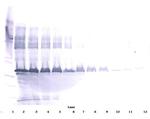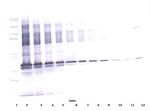Search Thermo Fisher Scientific
FIGURE: 1 / 3
ApoE3 Antibody (500-P238BT-25UG) in WB



Product Details
500-P238BT-25UG
Species Reactivity
Host/Isotype
Class
Type
Immunogen
Conjugate
Form
Concentration
Purification
Storage buffer
Contains
Storage conditions
Shipping conditions
RRID
Product Specific Information
AA Sequence of recombinant protein: MKVEQAVETE PEPELRQQTE WQSGQRWELA LGRFWDYLRW VQTLSEQVQE ELLSSQVTQE LRALMDETMK ELKAYKSELE EQLTPVAEET RARLSKELQA AQARLGADME DVCGRLVQYR GEVQAMLGQS TEELRVRLAS HLRKLRKRLL RDADDLQKRL AVYQAGAREG AERGLSAIRE RLGPLVEQGR VRAATVGSLA GQPLQERAQA WGERLRARME EMGSRTRDRL DEVKEQVAEV RAKLEEQAQQ IRLQAEAFQA RLKSWFEPLV EDMQRQWAGL VEKVQAAVGT SAAPVPSDNH.
Preparation: Produced from sera of rabbits immunized with highly pure Recombinant Human ApoE3. Anti-Human ApoE3-specific antibody was purified by affinity chromatography and then biotinylated.
Sandwich ELISA: To detect hApoE3 by sandwich ELISA (using 100 µL/well antibody solution) a concentration of 0.25-1.0 µg/mL of this antibody is required. This biotinylated polyclonal antibody, in conjunction with PeproTech Polyclonal Anti-Human ApoE3 (500-P238) as a capture antibody, allows the detection of at least 0.2-0.4 ng/well of Recombinant hApoE3.
Western Blot: To detect hApoE3 by Western Blot analysis this antibody can be used at a concentration of 0.1-0.2 µg/mL. Used in conjunction with compatible secondary reagents the detection limit for Recombinant hApoE3 is 1.5-3.0 ng/lane, under either reducing or non-reducing conditions.
500-P238BT-1MG will be provided as 2 x 500 µg
Target Information
ApoE belongs to a group of proteins that bind reversibly with lipoprotein and play an important role in lipid metabolism. In addition to facilitating solubilization of lipids, these proteins help to maintain the structural integrity of lipoproteins, serve as ligands for lipoprotein receptors, and regulate the activity of enzymes involved in lipid metabolism. Significant quantities of ApoE are produced in the liver and brain, and to some extent in almost every organ. ApoE is an important constituent of all plasma lipoproteins. Its interaction with specific ApoE receptor enables uptake of chylomicron remnants by liver cells, which is an essential step during normal lipid metabolism. It also binds with the LDL receptor (apo B/E). Defects in ApoE are a cause of hyperlipoproteinemia type III. ApoE exists in three major isoforms; E2, E3, and E4, which differ from one another by a single amino-acid substitution. E3 is the most common isoform and is present in 40-90% of the population.
For Research Use Only. Not for use in diagnostic procedures. Not for resale without express authorization.
References (0)
Bioinformatics
Protein Aliases: Apo-E; ApoE; Apolipoprotein E; apolipoprotein E3
Gene Aliases: AD2; APO-E; APOE; LDLCQ5; LPG
UniProt ID: (Human) P02649
Entrez Gene ID: (Human) 348

Performance Guarantee
If an Invitrogen™ antibody doesn't perform as described on our website or datasheet,we'll replace the product at no cost to you, or provide you with a credit for a future purchase.*
Learn more
We're here to help
Get expert recommendations for common problems or connect directly with an on staff expert for technical assistance related to applications, equipment and general product use.
Contact tech support
